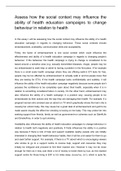Assess how the social context may influence the
ability of health education campaigns to change
behaviour in relation to health
In this essay I will be assessing how the social context may influence the ability of a health
education campaign in regards to changing behaviour. These social contexts include
embarrassment, availability, communication skills and acceptability.
Firstly, the factor of embarrassment is one social context which could influence the
effectiveness and ability of a health education campaign in regards to changing people’s
behaviour. If the behaviour the health campaign is trying to change is considered to be
based around a sensitive area (e.g. sexually transmitted diseases, drugs), people may be
too embarrassed to seek help or admit to having a problem in the first place. If for example
there is a small scale health campaign where they are offering walk-in STI tests for free,
people may be too affected by embarrassment to actually walk in and let people know that
they are testing for STI’s. If the health campaign lacks confidentiality and subtlety, it will
influence the ability of the health education campaign negatively because some people don’t
possess the confidence to be completely open about their health, especially when it is in
relation to something considered taboo in society. On the other hand, embarrassment may
also influence the ability of a health campaign in a positive way; causing people to be
embarrassed by their actions and the way they are damaging their health. For example, if a
pregnant woman who smoked saw an advert on TV which graphically shows the harm she is
causing her unborn baby, this may cause her a great deal of embarrassment and guilt to be
made aware visually the effect her smoking is having on her baby. This may probe her into
seeking support from friends, family as well as government-run schemes such as Start4Life
and SmokeFree, in order to quit smoking.
Availability also influences the ability of health education campaigns to change behaviour in
relation to health both negatively and positively. It firstly influences the ability in a positive
way because if there is lots of help and support available nearby people who are initially
interested in changing their health behaviour habits, then it will be a lot easier for them to go
and seek further support. For example, if there is a TV advert which is encouraging viewers
who smoke to go to a support centre to receive help, support and resources they may
initially be intrigued and proceed to find their nearest one. However it may not be close
enough for them as it may cost them a lot of money to travel there by bus, as the nearest
support centre for those living in EN1 is 5.5 miles away (SmokeFree, 2017), which is quite far,





